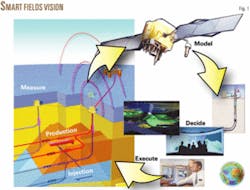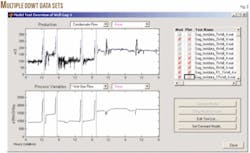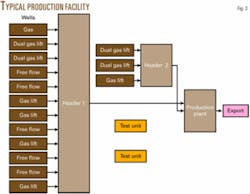Software installed in several Shell operated oil and gas fields transforms real-time data from commodity instrumentation via supervisory control and data acquisition (SCADA) systems and distributed control systems (DCS) into estimates of oil, water, and gas rates for all wells continuously.
Knowing what wells and reservoirs produce at all times facilitates improved asset management and integrity.
Shell has implemented its software, Fieldware Production Universe, during the last 2-3 years in 20 projects that now are seeing improved safety, increased production, reduced costs, reduced well testing, and improved hydrocarbon accounting.
The company plans to scale-up these benefits to full global brown and greenfield operations and transform the traditional manual operations culture into a new “smart fields” way of working based upon remote surveillance and control (Fig. 1).
Managing wells, reservoirs
A key upstream operations question is how does one effectively manage wells and reservoirs? The trite answer is “inadequately,” due to lack of a continuous, reliable measurements of well and reservoir performance on more than 90% of wells.
Measurements not taken continuously impede operations management, monitoring of well and reservoir performance, and hydrocarbon accounting.
Operating companies traditionally use discontinuous well testing to determine well performance. They typically test wells once per month and assume that the wells produce the same during the rest of the month. Nature usually is not that predictable, and the quality of the well tests often is unsatisfactory, requiring repeated tests.
Regulatory authorities specify a minimum well test frequency, such as once/month/well. Continuous well testing is more desirable; however, it is impractical to install a test separator for every well. At the heart of this problem is multiphase flow. Very few wells deliver a clean, measurable, single-phase stream, and it is impractical to install multiphase flowmeters on all wells.
The software application developed by Shell is capable of continuously estimating oil, gas, and water flows for all wells. The software enables improved well surveillance, more accurate hydrocarbon accounting, automatic production reporting, and production optimization.
The software enables safeguarding of the technical integrity of wells and reservoirs, for example early detection and control of gas, or water breakout. It is cost effective in that it requires minimal, commodity instrumentation and information technology systems, much of which may already be present in field operations.
The software is a module in Shell’s FieldWare suite of real-time applications. FieldWare applications are modular and are designed to be easily dropped into a personal computer (PC) based server network with access via either a thick or thin (web-based) client.
A thin client is a computer (client) in client-server architecture networks that depends primarily on the central server for processing activities. In contrast, a thick or fat client does as much processing as possible and passes only data required for communications and archival storage to the server.
The FieldWare applications are hence compatible with PC-based SCADA, DCS, or Historian systems.
Successful deployment of the production software also requires changing how people operate. This can be much harder than deploying the technology.
Software operations
The production-monitoring software uses dynamic data-driven models of the production system. The well models estimate water, oil, and gas production flows in real time, primarily from existing well instrumentation. These models capture such effects as back-out of weaker producers at headers.
The software does not use physical models such as well tubing diameters, roughness, fluid properties, near-wellbore skins, and presumed multiphase flow correlations. It relates, however, real-time well measurements to volumetric flows from test separators.
This data-driven approach has proven robust and usable in oil and gas production operations.
A key aspect of the software is the deliberately disturbed well test (DDWT), which is used to characterize well performance. These tests go beyond traditional production well testing. The objective is to relate well production (oil, gas, and water) to measured well parameters such as flowing tubinghead pressure, downhole pressure, gas-lift injection rate, and temperature.
The emphasis is on capturing the response of the well to step changes in controllable parameters.
The upper screen in Fig. 2 shows DDWT data in which five data sets model the well. In the lower screen, one can view the parameters used in the respective models. The upper right-hand panel provides a way to select and deselected models to achieve a best model fit.
Once created, the software uses the individual well models to compute the well production per stream. The software accumulates daily flow per well, which reflects the actual producing conditions, including trips and restarts, and plant operating mode changes.
The software constructs a simplified abstract topography that relates the wells to a calibration point (Fig. 3). Typically that point is a bulk separator, preferably providing oil, water, and gas measurement on a continuous basis.
The software compares production data per well and reconciles the production automatically against the installation’s overall export meter. This provides a reconciliation factor for each produced and injected stream on a continuous basis for the current day and the last 24 hr.
The screen also has a diagnostics panel alerting the user of production systems events, such as event detection, single-point measurements, or complex logic to detect specific events such as contamination of the water disposal stream with oil. Another part of screen provides an information panel that contains alerts on defective instruments and communications infrastructure.
With this single screen, an asset manager can gauge the current health of the production systems. If all the reconciliation factors are within acceptable bounds, the manager knows that the production system is under control-well models are accurate, instruments work, and the communications highway functions.
If this is not the case, that manager can access other screens that are at the process, header, and well level.
The output from measurements on the bulk separator provide a continuous 24 hr/day, 7 days/week data stream. The software uses the dynamic variation seen at the calibration point further to tune its well models. Plant trips and restarts are visible and generate useful data especially when the field is brought back on line.
The software updates the dynamic well models every 24 hr to reflect the total information available in the preceding period. This allows the software to track a decline in well rate or an increase in GOR and water cut (Fig. 4).
The software thrives on dynamics, such as increases or decreases in choke size, continuously to update individual well models.
Normal operations provide a dynamic environment with well interventions, process trips, etc. If wells exhibit stable production with minimal dynamics, then software can introduce dynamics. The software can choke wells up or down for short periods to cause transients to ripple through the process. It can introduce single or multiple disturbances simultaneously. These pseudo tests are known as deliberately disturbed production tests (DDPT’s). If these tests are insufficient to realign the models, then the software initiates a full DDWT.
The production software’s low maintenance, data-driven, production workflow-based (well test) modeling approach contrasts with the harder to sustain, specialized physical models requiring frequent tuning by process engineers. Building and upkeep of physical models are hard to sustain.
Well tests that are a normal part of oil and gas operation are the basis of the production software model’s workflow. The software also is more tolerant of errors in process measurements and instrument drift over time.
Experience to date
Shell’s implementation of the production software has yielded several benefits.
In moving to real-time operation and optimization, several field operations have reduced their production declines. In one field, the sustained reduction in production decline is in part attributed to more stable field operations and constant attention to well performance and adjustment of well parameters, such as early detection of coning, water breakthrough, and manual optimization.
Operators can optimize wells much more quickly by having a good understanding of well performance and the effect of changing separation pressures and well routing. The software provides immediate visibility of the changes. Where changes have a negative effect, they can be reversed immediately.
Historically the cycle time for optimization was days if not weeks. With the current version of the software, optimization of a field is possible daily or hourly from the office desktop.
With data being available in real time, operators can detect quickly underperforming wells and compensate for this by adjusting other wells or opening up closed in wells.
The net result is that fields with the software have reduced deferred production.
Implementation of the software has reduced the time spent by production technologists and operations engineers on gathering and validating well data and making decisions. This has allowed redeployment of scarce staff to other tasks. In one operation, a single operations engineer runs several fields where previously the work required five staff members.
With better well performance data, short and medium-term forecasts become more accurate. This has become evident in one particular field where actual production is consistently 5% above forecast. Previously the gap between forecast and actual was consistently a negative percentage.
The improved allocation of production to wells will influence the accuracy of long-term forecasts from reservoir simulators.
Several fields have reduced the variance in daily production. The peaks and troughs have leveled off. This again is thought to be a result from the attention paid to individual wells, daily field review and optimization, and reduced plant trips.
One field conducted no routine well test for 15 months, but the production software continued to run and track well performance and adjust the well models.
Other fields have seen a reduction in well testing duration. With software in place, more wells can be connected to one test facility. This lowers costs in the cases that the operations can have a single test train instead of two trains. Also the test separator can operate as a bulk vessel or for well service activity for longer periods.
The software also lets the operator know when a well needs to have a well test.
In another Shell operation, introduction of the software has reduced costs by allowing release of one service and transport vessel because operators no longer have to visit regularly the remote offshore location.
Fewer visits also lower health, safety, and environmental risks.
The production software has become a catalyst, focusing attention on the quality of production surveillance instrumentation and measurement data. The software is visible and used actively from field to asset-manager level so that problems with instrumentation or measurements become readily apparent because of deviations between well model predications and export flows.
Acknowledgments
The authors thank the management of Shell for permission to publish this paper and to contributors within Shell’s operations who assisted with development and implementation of the Production Universe software
The authors
Ron Cramer is a senior advisor with Shell Global Solutions, Houston, and works on oil field automation and production systems. Prior to Shell, he worked as a chemical engineer for Union Carbide and Polysar in downstream research and processing. Cramer holds a BS in chemical engineering from Strathclyde University, Glasgow, and an MS in chemical engineering from Waterloo University, Ontario.
Charlie Moncur is a senior production operations engineer with Shell Global Solutions, Rijswijk, the Netherlands. For the last 6 years he has worked as a R&D team leader for developing real-time applications (FieldWare Production Universe) and other related production management and optimization projects. His experience covers most facets of surface and subsurface production operations and IT development.








